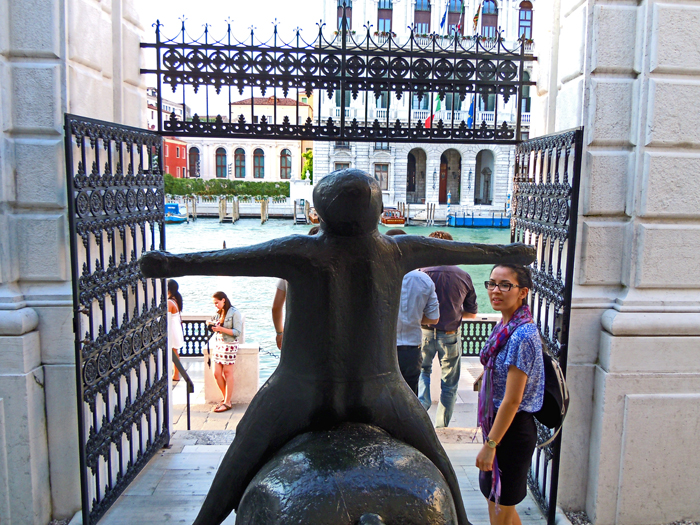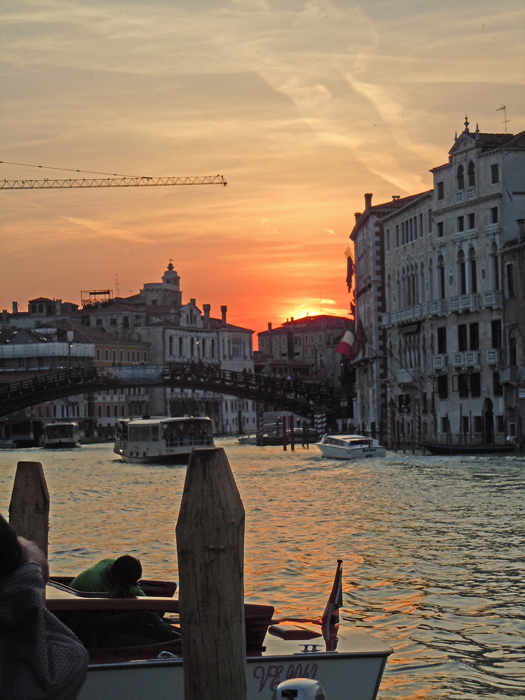Visiting the Peggy Guggenheim in Venice for the first time is an experience to remember. But visiting it for the first time as the sunsets at a private party with booming music and an Aperol sprits in your hand is another experience entirely. How a group of 30+ Canadian art history students got in thanks to our well connected professor I will never know, nor will I get to replicate the experience – although I am trying! If anyone knows how to get tickets to the Peggy Guggenheim’s evening parties please let me know!

Admittedly these featured highlights of the Peggy Guggenheim’s Sculpture Garden, also known as the Nesher Sculpture Garden, are my own favourites that affected me in some way. Each piece below has a personal emotional connection, wether it be where I began a conversation, contemplated the city of Venice in the light of the moon, or pondered the life and times of Peggy Guggenheim and her 14 beloved dogs before their very headstones. The Peggy Guggenheim is a hidden gem that too many overlook during their visit to the city of Doges. Escape from the crowds and basque in this charming gallery that once served as Peggy Guggenheim’s home along the Grand Canal.

Fritz Koenig’s Chariot (Biga) 1957
The German sculptor is known for creating his later work called Sphere which was installed at the base of the Twin Towers in New York. It ended up being the only work of art that wasn’t badly damaged after the 911 attacks.
However, this piece, Chariot (Biga) is a similar and smaller version of other larger casts you might see in Munich, Germany for example. A biga is a ceremonial chariot used in ancient Rome. Man, chariot and horses are one in this piece creating a strong insurmountable symbol. In 1957, the same year he created this piece, he was awarded a scholarship at the German Academy in Rome speaking to how the history and city itself may have spoke to him. He was also heavily influenced by African art and you can even see a similarity to the early work of Picasso in the in it’s simple shapes.

Mimmo Paladino’s The Cloven Viscount 1998 (cast in 2001)
Again we find simple lines by this Italian sculptor and even a face (a mask?) that is similar to Picasso’s Les Demoiselles D’Avingon. This is where you start to familiarize yourself with the Peggy Guggenheim’s taste for modern and postmodern works of art. Paladino’s piece can be compared to Jesus with palms open but is almost sexless, an outline. But because of its name we know that it s a noble man split in two. Behind the surface, if we were to walk around the sculpture, we would find that the sculpted man is actually split in two with a space, a gap, in between his front and back half. Imagine this piece in the darkness of Venice. Is this truly a split man or a tomb to crawl into and be kept in? It is alarming, ghostly almost with it’s hollow eyes and mouth just slightly agape. This was one of my most favourite pieces for its perplexing aura and the fact the it made me jump a bit after a couple spritzers.

Maurizio Nannucci’s Changing Place, Changing Time, Changing Thoughts, Changing Future 2003
While I don’t know too much about this Florentine artist I can say that this work, wether it is architectural, sculptural or both, I find it completely fitting to be installed at the Peggy Guggenheim in Venice. Venice is a place that is all at once timeless and yet a living historical museum. As time goes on this place hardly changes on its façade. It’s sinking, it’s in the midst of elegant decay and it changes you after you visit it. But visit it right. None of this cruising in for 5 hours. Peel your faces away from the tourist window shopping of nicknacks that were most likely made in China. Get lost and you could very well change your future. I found this neon quote fixed upon the wall profound. I was in the midst of change. If I hadn’t explored Venice when I did and experienced the people and places I did you would not be reading this now. There would be no blog. And I would be a reader wishing I could go to the places I read about.

Yoko Ono’s Wishing Tree Venice 2003
Not exactly sculpture, perhaps an argument could be made that a tree can be sculpted and altered making it a sort of organic sculpture that needs tending to. But nonetheless this is a highlight in the sculpture garden of Peggy Guggenheim. Yoko Ono, famous for being a rupture in the legendary fab four, The Beatles, she is also an established artist. Before, during and even after she met John Lennon she was performance artist participating in happenings during the 60s as well as conceptual art installations.
The wishing tree, although simple, is one of my favourite installations encouraging participation by the viewer to write their own wishes on white paper and tie it to the tree. The wish tree encourages messages of peace and have been placed in museums across the world from New York to Tokyo and has collected over one million wishes. The tree can be anything from an olive tree, apple, pomegranate, ficus, juniper or birch.
“As a child in Japan, I used to go to a temple and write out a wish on a piece of thin
paper and tie it around the branch of a tree. Trees in temple courtyards were always
filled with people’s wish knots, which looked like white flowers blossoming from afar.”
Yoko Ono: “All My Works Are A Form Of Wishing”.

Marino Marini’s The Angel of the City 1948 (cast 1950?)
Marini, an Italian sculptor, often used the horse and its rider within his work. As he continued his exploration of this union and equestrian themes the lines became harsher and much of his lines in the 40s were harsher consisting of the horse’s neck jutting out from its body and the rider mimicking the motions or vice versa. Both man and horse and dependent upon each other, although the man is looking up as if to connect his spirit to a higher power with arms stretched out as a cross. But his erection brings him back to a state of flesh, humanism and dependency. The body of the man and horse are solid and flexed resulting in the inevitable denouement of sexual strength.
I guarantee you, when you visit the Peggy Guggenheim, you’ll hear laughter when visitors first see this work.

Germaine Richier’s Tauromachy 1953
Germaine Richier was a female French sculptor who grew up in France and watched bull fights in Provence. Bull fighting, much like Picasso, had a lasting impression on her to the point where in much of her work there is a presence of the bull. However, she also worked within themes of decomposition as you can see in her piece Tauromachy. The bull is long dead and its slayer with a trident head may not be far behind with the subject’s hollowed decaying torso.
Imagine the bench behind this piece filled with young students, some Italian, some Canadian, all flirtatious and under the spell of Venice’s Guggenheim with Aperol to aid their nostalgic trip.

Peggy Guggenheim’s Gravestone & her 14 Dogs
One of the most surreal moments of the evening was stumbling upon the gravesite and headstone of Peggy Guggenheim herself as well as her 14 dogs. The museum’s building was in fact Peggy Guggenheim’s home. In the dinning room and bedrooms you can see works by Picasso, Braque, Duchamp and Magritte among others. You can observe sculptures like the Angel of the City and behold the most charming view of the Grand Canal where Peggy Guggenheim sipped coffee as her day began on the outdoor patio. It’s a charming gallery that I think is quite underrated. Yes, see the Doge’s Palace and stroll through San Marco Square but don’t miss ditching the hoards of people and slip into a few of Venice’s smaller galleries and museums.

You can see many of the works I talked about in this short video by the Peggy Guggenheim. I think it does a good job in capturing the magic the gallery possesses in such an elegant and historical city.

This post is part of the ArtSmart Roundtable where travel bloggers with an interest in art write monthly about a designated topic. This month the theme is Sculpture. To see what my colleagues wrote be sure to see below for their links.


What a nice place, I love garden and sculptures…… I will love to go soon!
Beautiful photos!
This looks like a place we would enjoy, and I enjoyed all your photos. I was especially interested in the Egyptian mummies. Thank you so much.
I love places like this one, never knew of its existence. Adding another must-see to my list of places to visit in Italy! Thanks for sharing!
I am glad you found it interesting. It’s a great spot that is shockingly not packed with tourists. I’m heading back to Venice this June and it’s within my top 3 places to see again with 2 newbies joining me.
I really love the Chariot piece! It’s such a beautiful blend of ancient and modern, and I love the nod to the Italian past in a city that largely has no ancient ruins.
Also, your professor must have been REALLY well connected! A sunset party in a museum in Venice sounds divine.
I love that piece too Erin. You can really see how he was influenced by the city of Rome during his stay as he was working on it.
She was very well connected. I contacted her to see if I could experience it again but alas I am arriving 2 days too late if you can believe it. A bit of a disappointment but I am just glad I was able to experience it when I did.
If you google “white nights of Venice” you might be able to discover the party and buy tickets. This year (2014) it’s held on June 22nd. Worth the trip if you already live in Europe.
It looks like a fantastic place, thanks for the tour and for the hidden gem of the headstone for the 14 pooches, a first of its kind for me, I think. I keep seeing places from Venice that I barely knew existed, so it’s becoming more and more obvious that it’s time to go back, twenty years ago was a lifetime away… Will try to crash the evening parties somehow too, we’ll see how that works out 😉
You should definitely try and time your visit with the “White Nights of Venice” as it is called – I found out by asking a few Venetian locals on Twitter. This year it is held on June 22nd – 2 days before I arrived this time! Doh!!!
Thanks for your comment Pal!
Looks interesting – definitely somewhere I’d like to visit! Thanks for an informative write up 🙂
It’s a great spot to escape the crowds of tourists. Few venture to the Dorsoduro area unless they are lost trying to make their way to the San Marco Square.
Thanks for stopping by Lizzie.
PS I see you wrote about Mauritius which is a coincidence for me. I dreamt about visiting there while doing a French Immersion project in school, learning about the various places in the world other than France that speak French.
Thanks for the tour, Murissa! Twice I’ve tried to visit this museum and both times found it closed:\ I especially like the Koenig and the Nannucci. In October in Chelsea, NYC, I came across a Yoko Ono wishing tree and participated. How delightful that versions of this simple, interactive work can be encountered so serendipitously around the world.
It’ll make your 3rd visit all the more special Lesley!
Love the wishing tree. I didn’t get to write a wish last time but I will definitely this time around in June.
It’ll be for you to be able to experience the P. Guggenheim during your next visit 😉